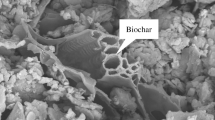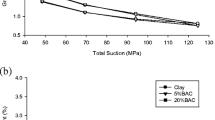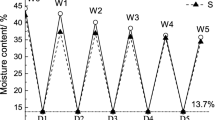Abstract
Compacted biochar-amended clay (BAC) has been proposed as an alternative landfill final cover material in this study. Biochar has long been proposed to promote crop growth, mitigate odor emission, and promote methane oxidation in field soils. However, previous studies showed that soil-gas permeability was increased upon biochar application, which will promote landfill gas emission. The objective of the present study is to investigate the possibility of using compacted BAC as an alternative material in landfill final cover by evaluating its gas permeability. BAC samples were prepared by mixing 425-μm-sieved peanut shell biochar with kaolin clay in different ratios (0, 5, 10, and 15 %, w/w) and compacting at different degrees of compactions (DOC) (80, 85, and 90 %) with an optimum water content of 35 %. The gas permeability of the BACs was measured by flexible wall gas permeameter and the microstructure of the BACs was analyzed by SEM with energy-dispersive x-ray spectroscopy (EDX). The results show that the effects of biochar content on BAC gas permeability is highly dependent on the DOC. At high DOC (90 %), the gas permeability of BAC decreases with increasing biochar content due to the combined effect of the clay aggregation and the inhibition of biochar in the gas flow. However, at low DOC (80 %), biochar incorporation has no effects on gas permeability because it no longer acts as a filling material to the retard gas flow. The results from the present study imply that compacted BAC can be used as an alternative final cover material with decreased gas permeability when compared with clay.




Similar content being viewed by others
References
Ahmad M, Rajapaksha AU, Lim JE, Zhang M, Bolan N, Mohan D, Vithanage M, Lee SS, Ok YS (2014) Biochar as a sorbent for contaminant management in soil and water: a review. Chemosphere 99:19–33
Asai H, Samson BK, Stephan HM, Songyikhangsuthor K, Homma K, Kiyono Y, Inoue Y, Shiraiwa T, Horie T (2009) Biochar amendment techniques for upland rice production in northern Laos: 1. soil physical properties, leaf SPAD and grain yield. Field Crop Res 111(1):81–84
ASTM (2007) Standard test method for particle-size analysis of soils. ASTM D422-63. American Society for Testing and Materials, Philadelphia
Bouazza A, Vangpaisal T (2003) An apparatus to measure gas permeability of geosynthetic clay liners. Geotext Geomembr 21(2):85–101
Bronick CJ, Lal R (2005) Soil structure and management: a review. Geoderma 124(1):3–22
Deepagoda T, Moldrup P, Schjønning P, Jonge LW, Kawamoto K, Komatsu T (2011) Density-corrected models for gas diffusivity and air permeability in unsaturated soil. Vadose Zone J 10(1):226–238
Elshorbagy W, Mohamed A (2000) Evaluation of using municipal solid waste compost in landfill closure caps in arid areas. Waste Manag 20(7):499–507
Gallé C (2001) Effect of drying on cement-based materials pore structure as identified by mercury intrusion porosimetry: a comparative study between oven-, vacuum-, and freeze-drying. Cem Concr Res 31(10):1467–1477
Hamamoto S, Moldrup P, Kawamoto K, Komatsu T (2009) Effect of particle size and soil compaction on gas transport parameters in variably saturated, sandy soils. Vadose Zone J 8(4):986–995
Kettunen RH, Einola JM, Rintala JA (2006) Landfill methane oxidation in engineered soil columns at low temperature. Water Air Soil Pollut 177(1-4):313–334
Koerner RM (2012) Designing with geosynthetics. Xlibris Corporation
Kolb T, Agee J, Fule P, McDowell N, Pearson K, Sala A, Waring R (2007) Perpetuating old ponderosa pine. For Ecol Manag 249(3):141–157
Lehmann J (2007) Bio-energy in the black. Front Ecol Environ 5(7):381–387
Lehmann J, Joseph S (2009) Biochar for environmental management: science and technology. Earthscan
Liu X, Han F, Zhang X (2012) Effect of biochar on soil aggregates in the loess plateau: results from incubation experiments. Int J Agric Biol 14(6):975–979
McHenry MP (2011) Soil organic carbon, biochar, and applicable research results for increasing farm productivity under Australian agricultural conditions. Commun Soil Sci Plant Anal 42(10):1187–1199
Mohan D, Sarswat A, Ok YS, Pittman CU Jr (2014) Organic and inorganic contaminants removal from water with biochar, a renewable, low cost and sustainable adsorbent—a critical review. Bioresour Technol 160:191–202
Moldrup P, Olesen T, Komatsu T, Schjønning P, Rolston D (2001) Tortuosity, diffusivity, and permeability in the soil liquid and gaseous phases. Soil Sci Soc Am J 65(3):613–623
Moo-Young HK, Zimmie TF (1996) Geotechnical properties of paper mill sludges for use in landfill covers. J Geotech Eng 122(9):768–775
Raco B, Battaglini R, Lelli M (2010) Gas emission into the atmosphere from controlled landfills: an example from Legoli landfill (Tuscany, Italy). Environ Sci Pollut Res 17(6):1197–1206
Reddy KR, Yargicoglu EN, Yue D, Yaghoubi P (2014) Enhanced microbial methane oxidation in landfill cover soil amended with biochar. J Geotech Geoenviron 140(9):04014047
Scheutz C, Pedersen GB, Costa G, Kjeldsen P (2009) Biodegradation of methane and halocarbons in simulated landfill biocover systems containing compost materials. J Environ Qual 38(4):1363–1371
Shang G, Shen G, Wang T, Chen Q (2012) Effectiveness and mechanisms of hydrogen sulfide adsorption by camphor-derived biochar. J Air Waste Manage Assoc 62(8):873–879
Shang G, Shen G, Liu L, Chen Q, Xu Z (2013) Kinetics and mechanisms of hydrogen sulfide adsorption by biochars. Bioresour Technol 133:495–499
Sombroek W, Ruivo MDL, Fearnside PM, Glaser B, Lehmann J (2003) Amazonian dark earths as carbon stores and sinks. Amazonian dark earths. pp. 125-139 Springer
Sun Z, Moldrup P, Elsgaard L, Arthur E, Bruun EW, Hauggaard-Nielsen H, de Jonge LW (2013) Direct and indirect short-term effects of biochar on physical characteristics of an arable sandy loam. Soil Sci 178(9):465–473
US EPA (1989) Technical guidance document: final covers on hazardous waste landfills and surface impoundments. US Environmental Protection Agency, Washington
Xu X, Cao X, Zhao L, Sun T (2014) Comparison of sewage sludge-and pig manure-derived biochars for hydrogen sulfide removal. Chemosphere 111:296–303
Yu L, Tang J, Zhang R, Wu Q, Gong M (2013) Effects of biochar application on soil methane emission at different soil moisture levels. Biol Fertil Soils 49(2):119–128
Zhao L, Cao X, Mašek O, Zimmerman A (2013) Heterogeneity of biochar properties as a function of feedstock sources and production temperatures. J Hazard Mater 256:1–9
Acknowledgments
This study was funded by the research grant 2012CB719805 of 2012CB719800 provided by the Ministry of Science and Technology of the People’s Republic of China through the National Basic Research Program (973 project) and Collaborative Research Fund (CRF) provided by the Research Grants Council of the Hong Kong SAR (HKUST6/CRF/12R). The authors would like to thank Mr. Yeung Yin Hon and Ms. Charlotte Ma for their technical assistance.
Author information
Authors and Affiliations
Corresponding authors
Additional information
Responsible editor: Zhihong Xu
Rights and permissions
About this article
Cite this article
Wong, J.T.F., Chen, Z., Ng, C.W.W. et al. Gas permeability of biochar-amended clay: potential alternative landfill final cover material. Environ Sci Pollut Res 23, 7126–7131 (2016). https://doi.org/10.1007/s11356-015-4871-2
Received:
Accepted:
Published:
Issue Date:
DOI: https://doi.org/10.1007/s11356-015-4871-2




